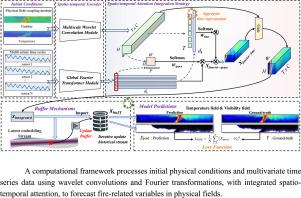Predicting fire dynamics in ventilated tunnels with spatio-temporal buffer network
IF 7.4
1区 工程技术
Q1 CONSTRUCTION & BUILDING TECHNOLOGY
引用次数: 0
Abstract
Tunnel fires pose significant threats to public safety and urban infrastructure. Prompt responses and the implementation of effective firefighting measures are crucial for reducing losses from tunnel fires. However, current approaches lack high-precision and long-term prediction methods for various physical fields in tunnel fires. To address this issue, this paper proposes a deep learning model capable of predicting the development of multiple physical parameters in tunnel fires, such as temperature and visibility: Multi-Granularity Spatiotemporal Buffer Network (MUST-BN). MUST-BN simplifies the integration of multiple physical fields by using multi-scale wavelet convolution modules and global Fourier transform modules. It effectively captures the inherent spatiotemporal relationships in fire dynamics. Additionally, the model employs a spatiotemporal attention mechanism to seamlessly merge information from the two modules. It also introduces a buffer mechanism that connects the neural network with data streams to improve long-term prediction accuracy. This paper constructs a FIT dataset by simulating various tunnel fire scenarios, providing learning data for the model. Deep learning numerical results show that MUST-BN exhibits small prediction errors in forecasting tunnel fire-related parameters, with prediction errors for temperature and visibility below 5%. Furthermore, comparative analyses with other state-of-the-art models reveal that MUST-BN significantly outperforms them in temperature prediction, achieving a mean squared error of 0.0342 and a structural similarity index measure of 0.9117. These results indicate that MUST-BN effectively models the interactions of multiple physical fields and provides reliable long-term predictions, thereby offering valuable support for fire safety planning and emergency response in tunnel environments. We provide our complete code and dataset at the following URL: https://github.com/Fire-pre/MUST-BN/tree/main.

基于时空缓冲网络的通风隧道火灾动态预测
隧道火灾对公共安全和城市基础设施构成重大威胁。及时响应和实施有效的消防措施对于减少隧道火灾的损失至关重要。然而,目前的方法缺乏对隧道火灾中各种物理场的高精度和长期预测方法。为了解决这一问题,本文提出了一种能够预测隧道火灾中多个物理参数(如温度和能见度)发展的深度学习模型:多粒度时空缓冲网络(Multi-Granularity Spatiotemporal Buffer Network, MUST-BN)。MUST-BN通过使用多尺度小波卷积模块和全局傅里叶变换模块简化了多个物理场的积分。它有效地捕捉了火灾动力学中固有的时空关系。此外,该模型还采用了一种时空注意机制来无缝地合并两个模块的信息。它还引入了一种缓冲机制,将神经网络与数据流连接起来,以提高长期预测的准确性。本文通过模拟各种隧道火灾场景,构建FIT数据集,为模型提供学习数据。深度学习数值结果表明,MUST-BN对隧道火灾相关参数的预测误差较小,对温度和能见度的预测误差在5%以下。此外,与其他先进模型的对比分析表明,MUST-BN在温度预测方面明显优于它们,均方误差为0.0342,结构相似性指数为0.9117。这些结果表明,MUST-BN可以有效地模拟多个物理场的相互作用,并提供可靠的长期预测,从而为隧道环境中的消防安全规划和应急响应提供有价值的支持。我们通过以下URL提供完整的代码和数据集:https://github.com/Fire-pre/MUST-BN/tree/main。
本文章由计算机程序翻译,如有差异,请以英文原文为准。
求助全文
约1分钟内获得全文
求助全文
来源期刊

Tunnelling and Underground Space Technology
工程技术-工程:土木
CiteScore
11.90
自引率
18.80%
发文量
454
审稿时长
10.8 months
期刊介绍:
Tunnelling and Underground Space Technology is an international journal which publishes authoritative articles encompassing the development of innovative uses of underground space and the results of high quality research into improved, more cost-effective techniques for the planning, geo-investigation, design, construction, operation and maintenance of underground and earth-sheltered structures. The journal provides an effective vehicle for the improved worldwide exchange of information on developments in underground technology - and the experience gained from its use - and is strongly committed to publishing papers on the interdisciplinary aspects of creating, planning, and regulating underground space.
 求助内容:
求助内容: 应助结果提醒方式:
应助结果提醒方式:


